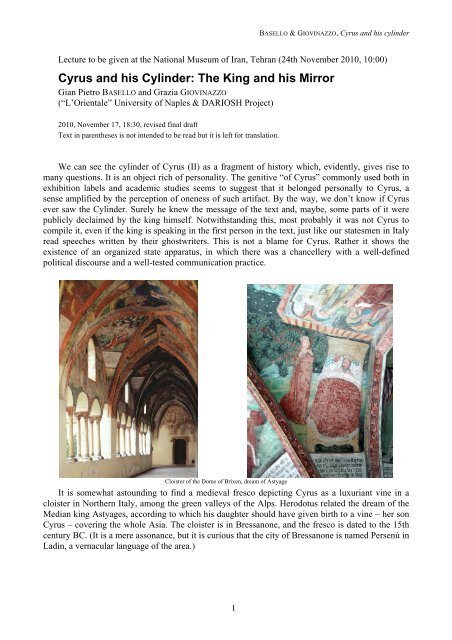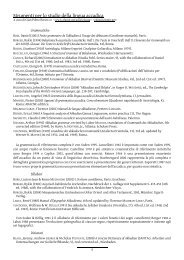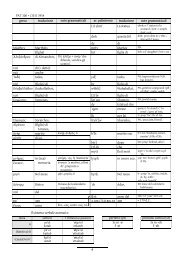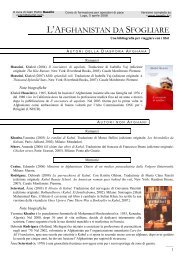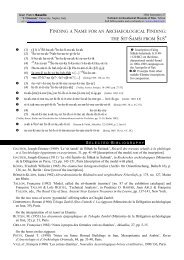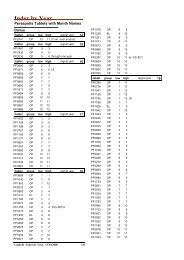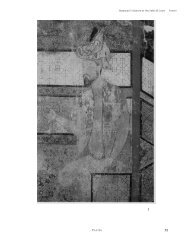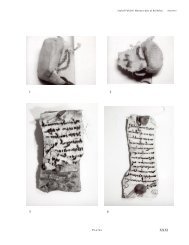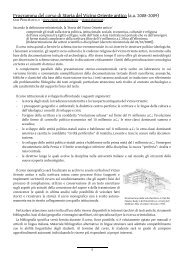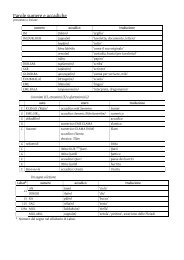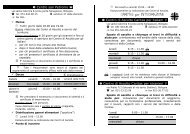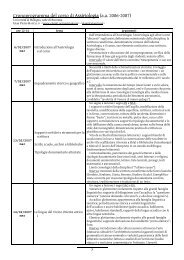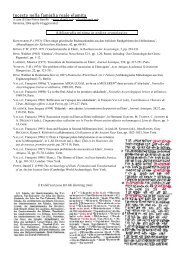Cyrus and his Cylinder: The King and his Mirror - Elam.net
Cyrus and his Cylinder: The King and his Mirror - Elam.net
Cyrus and his Cylinder: The King and his Mirror - Elam.net
Create successful ePaper yourself
Turn your PDF publications into a flip-book with our unique Google optimized e-Paper software.
BASELLO & GIOVINAZZO, <strong>Cyrus</strong> <strong>and</strong> <strong>his</strong> cylinder<br />
Lecture to be given at the National Museum of Iran, Tehran (24th November 2010, 10:00)<br />
<strong>Cyrus</strong> <strong>and</strong> <strong>his</strong> <strong>Cylinder</strong>: <strong>The</strong> <strong>King</strong> <strong>and</strong> <strong>his</strong> <strong>Mirror</strong><br />
Gian Pietro BASELLO <strong>and</strong> Grazia GIOVINAZZO<br />
(“L’Orientale” University of Naples & DARIOSH Project)<br />
2010, November 17, 18:30, revised final draft<br />
Text in parentheses is not intended to be read but it is left for translation.<br />
We can see the cylinder of <strong>Cyrus</strong> (II) as a fragment of <strong>his</strong>tory which, evidently, gives rise to<br />
many questions. It is an object rich of personality. <strong>The</strong> genitive “of <strong>Cyrus</strong>” commonly used both in<br />
exhibition labels <strong>and</strong> academic studies seems to suggest that it belonged personally to <strong>Cyrus</strong>, a<br />
sense amplified by the perception of oneness of such artifact. By the way, we don’t know if <strong>Cyrus</strong><br />
ever saw the <strong>Cylinder</strong>. Surely he knew the message of the text <strong>and</strong>, maybe, some parts of it were<br />
publicly declaimed by the king himself. Notwithst<strong>and</strong>ing t<strong>his</strong>, most probably it was not <strong>Cyrus</strong> to<br />
compile it, even if the king is speaking in the first person in the text, just like our statesmen in Italy<br />
read speeches written by their ghostwriters. T<strong>his</strong> is not a blame for <strong>Cyrus</strong>. Rather it shows the<br />
existence of an organized state apparatus, in which there was a chancellery with a well-defined<br />
political discourse <strong>and</strong> a well-tested communication practice.<br />
Cloister of the Dome of Brixen, dream of Astyage<br />
It is somewhat astounding to find a medieval fresco depicting <strong>Cyrus</strong> as a luxuriant vine in a<br />
cloister in Northern Italy, among the green valleys of the Alps. Herodotus related the dream of the<br />
Median king Astyages, according to which <strong>his</strong> daughter should have given birth to a vine – her son<br />
<strong>Cyrus</strong> – covering the whole Asia. <strong>The</strong> cloister is in Bressanone, <strong>and</strong> the fresco is dated to the 15th<br />
century BC. (It is a mere assonance, but it is curious that the city of Bressanone is named Persenù in<br />
Ladin, a vernacular language of the area.)<br />
1
BASELLO & GIOVINAZZO, <strong>Cyrus</strong> <strong>and</strong> <strong>his</strong> cylinder<br />
Tapestries with the Stories of <strong>Cyrus</strong>, Museo Bagatti Valsecchi, Milan (Forti Grazzini, ‘Gli arazzi’, in Museo Bagatti Valsecchi, vol. 2)<br />
At the Bagatti Valsecchi house museum in Milan, we can find even 16th century tapestries with<br />
four episodes of the cycle known as Stories of <strong>Cyrus</strong>. On a tapestry, below the figure of <strong>Cyrus</strong> in<br />
throne, t<strong>his</strong> motto is embroidered: ‘war brings fame, but a kingdom is founded on justice <strong>and</strong><br />
liberality’.<br />
Motto in a tapestry with the Stories of <strong>Cyrus</strong>, Museo Bagatti Valsecchi, Milan (Forti Grazzini, ‘Gli arazzi’, in Museo Bagatti Valsecchi, vol. 2)<br />
<strong>The</strong>refore, both on tapestries <strong>and</strong> in a fresco in Italy, <strong>Cyrus</strong> is a positive figure, image of the<br />
enlightened monarch, whose reign brings peace <strong>and</strong> justice: exactly the same message of the<br />
<strong>Cylinder</strong>. It is interesting to note that both the Bible (above all Isaiah 45) <strong>and</strong> Herodotus (Histories<br />
I) concurred, with their different traditions <strong>and</strong> perspectives, in moulding t<strong>his</strong> image of <strong>Cyrus</strong> in the<br />
West. Two episodes of the Stories at the Bagatti Valsecchi museum are related to the battle against<br />
the Massagetae as recounted by Herodotus, while the other two, concerning the edict in favour of<br />
the Hebrew people, are from the Bible.<br />
Tapestry of Saint <strong>Cyrus</strong>, Gesù Nuovo church in Naples<br />
(Marginally, one of the most venerated saints in Naples, where is located our University, bears<br />
the name <strong>Cyrus</strong>. He was a physician from Alex<strong>and</strong>ria in Egypt <strong>and</strong> died around 300 AD; probably<br />
2
BASELLO & GIOVINAZZO, <strong>Cyrus</strong> <strong>and</strong> <strong>his</strong> cylinder<br />
he took the name from the Achaemenid king, eight centuries after the son of <strong>Cyrus</strong> conquered<br />
Egypt. Even today, the name <strong>Cyrus</strong> (Ciro in Italian) is widely attested among Neapolitan people.)<br />
Coming back to the Bible, the passages related to <strong>Cyrus</strong> are especially focused on the royal<br />
chancellery <strong>and</strong> its communication practice. In the Bible book of Ezra 1:1 it is stated that <strong>Cyrus</strong>, in<br />
order to communicate <strong>his</strong> royal will, ‘had (causative verbal form) the (i.e. <strong>his</strong>) voice (qol) spread<br />
<strong>and</strong> also (gam) in (be) writing (miktab)’, i.e. with an edict. <strong>The</strong>n follow, in a somewhat pleonastic<br />
way, the usual introductory formula ‘Thus <strong>Cyrus</strong> said’. T<strong>his</strong> form is widely attested in the books of<br />
the Bible; it is well-known also from the Achaemenid inscriptions, since Darius the Great on (θāti<br />
dārayavauš xšāyaθya).<br />
In the book of Ezra 1:8, we read that ‘<strong>Cyrus</strong>, the king of Persia, had some vessels (keli, a<br />
generic term) brought out (yaṣa’) <strong>and</strong> counted (safar) by the treasurer (gezbar) in front of (le) the<br />
prince of Judah’. <strong>The</strong> word for treasurer, gezbar, elsewhere gizzavar, is a loanword from Old<br />
Persian *ganza-bara-; the name of the treasurer, Mithredat, is clearly Iranian (*miθradāta-), too.<br />
<strong>The</strong> vessels were, precisely, ‘at (‘al) the h<strong>and</strong> (yad) of the treasurer’. T<strong>his</strong> expression is a reminder<br />
of Aramaic lyd, attested on the Aramaic texts on stone vessels from Takht-e Jamshid, in turn a<br />
calque of Akkadian ša qat <strong>and</strong>, perhaps, of <strong>Elam</strong>ite kurman (if kurman in the administrative<br />
documents from Takht-e Jamshid is connected to the word kurpi ‘h<strong>and</strong>s’ in the Bisotun inscription).<br />
<strong>The</strong> translation given above is a literal one: obviously, the meaning has to be transposed, so ‘at the<br />
h<strong>and</strong>’ means ‘under the responsibility of’, ‘to bring out’ means ‘to release’, <strong>and</strong> ‘to count in front<br />
of’ means ‘to attest’ or the like.<br />
More words should be spent on the asserted oneness of the <strong>Cylinder</strong>. First of all, it is certainly<br />
not unique for its shape <strong>and</strong> material: clay cylinders are attested in several instances from<br />
Mesopotamia.<br />
(Ellis, Foundation Deposits in Ancient Mesopotamia, fig. 36)<br />
Going back in time, two cylinders of Gudea, the Sumerian sovereign of the 22nd century BC,<br />
are known. A four-sided prism (i.e. a parallelepiped of clay, similar to a st<strong>and</strong>ing quadrangular<br />
stone), ca. 30 cm high, provides a chronological list of the Larsa dynasty (20th-18th century BC).<br />
3
BASELLO & GIOVINAZZO, <strong>Cyrus</strong> <strong>and</strong> <strong>his</strong> cylinder<br />
(Ellis, Foundation Deposits in Ancient Mesopotamia, fig. 30)<br />
In the neo-Assyrian period, pentagonal, hexagonal, octagonal <strong>and</strong> decagonal prisms were also<br />
used for writing royal inscriptions. Barrel cylinders <strong>and</strong> prisms of Sargon II (four cylinders with the<br />
same text from Khorsabad, prisms A <strong>and</strong> B from Niniveh), Sennacherib (Bellino <strong>and</strong> Rassam<br />
cylinders, Taylor prism), Esarhaddon (Eanna cylinder, various prisms) <strong>and</strong> Assurbanipal (Rassam<br />
cylinder <strong>and</strong> many others) are known. Prisms are well attested for Esarhaddon while cylinders were<br />
especially used for Assurbanipal.<br />
But especially in the neo-Babylonian period, i.e. just few decades before <strong>Cyrus</strong>, the barrel<br />
cylinder seems to have been the favourite support for royal inscriptions. From the last Babylonian<br />
king Nabonidus we have ca. 20 royal inscriptions written on cylinders, some known by several<br />
exemplars. <strong>The</strong>y are collected by the German assyriologist Hanspeter Schaudig in <strong>his</strong><br />
comprehensive study on Nabonidus <strong>and</strong> <strong>Cyrus</strong> inscriptions published in 2001.<br />
<strong>The</strong> inscriptions on cylinders <strong>and</strong> prisms attracted the interest of scholars for their richness both<br />
for the study of language <strong>and</strong> <strong>his</strong>tory. For example, Giovanni V. Schiaparelli, the famous Italian<br />
astronomer <strong>and</strong> <strong>his</strong>torian of sciences who died exactly a hundred years ago, used the text of the socalled<br />
“Taylor prism” of Sennacherib to study cuneiform (Archivio della Specola di Brera, A<br />
427/002 SCH).<br />
Taylor prism<br />
Even if poorly attested, barrel cylinders were used also at Shush by the Achaemenid king<br />
Darius. Fragments attest that the building inscription DSf was written on such a support at least in<br />
its <strong>Elam</strong>ite <strong>and</strong> Babylonian versions (DSf/AE 09 <strong>and</strong> DSf/AB 024-026 in MDP 53). Otherwise,<br />
Darius, Xerxes <strong>and</strong> Artaxerxes (I) seem to have preferred the stone table (DSz/AE <strong>and</strong> DSaa/AB,<br />
XPf/OPa, A 1 Pb/AB) or metal plaque (DPh) as a support for their inscriptions actually placed in<br />
building deposits.<br />
4
BASELLO & GIOVINAZZO, <strong>Cyrus</strong> <strong>and</strong> <strong>his</strong> cylinder<br />
Discovery of inscribed tables in the so-called Garrison Quarters at Persepolis (Oriental Institute, Chicago)<br />
Leaping after <strong>Cyrus</strong>, in post Achaemenid times, even Antiochus I Soter (c. 324-261 BC), the<br />
Seleucid king, had <strong>his</strong> cylinder written; it was found in Borsippa, c. 18 km South-West of Babylon.<br />
<strong>Cylinder</strong>s <strong>and</strong> prisms might be solid or hollow. <strong>The</strong> cylinder of <strong>Cyrus</strong> is solid. <strong>The</strong> hollow ones<br />
were manufactured like a pot on the potter’s wheel. <strong>The</strong> size varies considerably, ‘ranging from less<br />
than ten centimeters in length to more than thirty’; for example, the prism of Tiglath-Pileser I (c.<br />
1100 BC) from Assur is more than half a meter high. <strong>The</strong> shape of cylinders varies from a barrel<br />
cylinder to nearly a true cylinder. <strong>The</strong>y are inscribed along their main axis whereas each face of a<br />
prism is inscribed as a column, i.e. perpendicularly to the main axis. Prismoid, i.e. barrel prism<br />
written along the main axis like cylinders, were also used, like the one of Sargon II from<br />
Khorsabad.<br />
Prism of Tiglath-Pileser I in situ, Anu-Adad temple at Assur (Andrae, Jüngere Ischtar-Tempel, fig. 12)<br />
<strong>The</strong>re are also cylinders <strong>and</strong> prisms used for writing other textual typologies besides royal<br />
inscriptions. Most of such prisms are pierced with a hole along the axis; also some hollow cylinders<br />
with royal inscription have these holes. Perhaps they have been intended to receive a stick as<br />
rotation device; such a device could be used for easy displaying, storing or copying the text.<br />
According to Ellis, such device was useful in inscribing the cylinder without touching its wet clay<br />
with the scribe’s h<strong>and</strong>s.<br />
How did come in use such a peculiar shape<br />
In our opinion, the model for the cylinders is the cylinder seal. Seals were very important tools<br />
in the ancient Near East. <strong>The</strong>y were a kind of signature <strong>and</strong> identity card, not only for individuals<br />
but also for institutions <strong>and</strong> offices, just as a stamp before the digital revolution: it means property<br />
<strong>and</strong> was as personal as a cellular phone or a credit card today. Seals were generally figurative so the<br />
5
BASELLO & GIOVINAZZO, <strong>Cyrus</strong> <strong>and</strong> <strong>his</strong> cylinder<br />
cylinders are like clay cylinder seals whose surface is thoroughly written. <strong>The</strong> cylinder of <strong>Cyrus</strong> is a<br />
great seal whose written legend occupies the whole surface, including the room usually left for<br />
figurative parts in cylinder seals. A low stone prism of Esarhaddon with text <strong>and</strong> figuration (ME<br />
91027) can be placed in the middle between cylinder seals <strong>and</strong> cylinders, also for its size; it is in<br />
stone as a cylinder seal but its text is a building inscription as in a cylinder.<br />
Left: Stone prism of Esarhaddon (ME 91027, British Museum)<br />
Right: Impression on end of Esarhaddon’s prism WA 78223 (Finkel & Reade, ‘Assyrian Hieroglyphs, Zeitschrift für Assyriologie, 86 (1996), fig. 21)<br />
<strong>The</strong>re is also, probably, another compulsory reason for t<strong>his</strong> shape. Just think of a lasting support<br />
for a writing. Probably you will think of a stone or marble slab; here in Iran you have also the<br />
beautiful glazed tiles which delight us foreigners visiting Esfahan <strong>and</strong> other Iranian monuments. But<br />
slabs <strong>and</strong> tiles are for monumental public writings. If you want to preserve the same message in a<br />
hidden place, you may think of a metal plaque densely engraved with writing; yes, t<strong>his</strong> is a problem<br />
for us usually writing on paper with ink. What if you write in a three-dimensional script like the<br />
cuneiform on a plastic support You can mould a clay tablet as usual or, maybe, for many reasons,<br />
you want something less usual than a tablet. So you can mould the clay in a more particular <strong>and</strong><br />
symmetrical fashion: the cylinder or the prism. <strong>The</strong>se were probably the most economic solutions in<br />
terms of space. <strong>The</strong> barrel shape can be a consequence of the wheel manufacture. In t<strong>his</strong> way we<br />
can connect the cylinders to the clay cones, both for their shape (being somewhat half a barrel<br />
cylinder) <strong>and</strong> functions.<br />
Last but not least, the cylinder is a perfect solid <strong>and</strong> the power of the written words could be<br />
magically repeated by its surface without ends. We can see a sort of continuity both in time (the<br />
durable support) <strong>and</strong> in space (the continuous surface). In our opinion, the rotation axis was a<br />
consequence of the shape of such a support <strong>and</strong> was used to display the text, maybe also to let the<br />
text magically “speak” by itself, rotating the support on the stick.<br />
A general treatment of these kinds of support was written by Richard S. Ellis; Hanspeter<br />
Schaudig <strong>and</strong>, recently, Rocio Da Riva dealt especially with the exemplars from neo-Babylonian<br />
period. Prof. Adriano Rossi, director of the DARIOSH Project for Achaemenid epigraphy, gave a<br />
still unpublished lecture discussing the relationships between these supports <strong>and</strong> the functions <strong>and</strong><br />
typologies of their texts. That is what we try to do in what follows.<br />
Above, we told that you had to hide the text you want to preserve for long time. T<strong>his</strong> was<br />
because cylinders <strong>and</strong> prisms were often found in building deposits, i.e. small closets or hidden<br />
recesses somewhere in a building, not only in the foundations but often in the brickwork instead of<br />
a brick.<br />
6
BASELLO & GIOVINAZZO, <strong>Cyrus</strong> <strong>and</strong> <strong>his</strong> cylinder<br />
Findspot of the cylinder of Nabonidus in the North wall of the Ishtar temple at Babylon (Reuther, Die Innenstadt von Babylon. Merkes, fig. 88)<br />
In order to underst<strong>and</strong> these deposits, we have to think about memory lasting in time: memory<br />
of the name of the king, memory of <strong>his</strong> deeds, i.e. war campaigns <strong>and</strong>, especially, building<br />
activities. Only the king was the true leader <strong>and</strong> builder. In these tasks the king can show <strong>his</strong> power,<br />
as the most valiant <strong>and</strong> skilled craftsman. Also in iconography, the king was shown as a mason (see<br />
the stone plaque of Ur-Nanshe from Lagash, dated to 25th cent. BC, the foundation figure of Ur-<br />
Nammu from Uruk <strong>and</strong> the two stelae of Assurbanipal) or architect (Gudea) in Mesopotamia.<br />
Foundation deposit in the Emah temple at Babylon (Koldewey, Die Tempel von Babylon und Borsippa, fig. 15)<br />
<strong>The</strong> building was nothing without its sponsor: the name of the king was relevant as much as the<br />
memory of the building: in Sumerian, the royal inscriptions were called simply MU.SARA ‘written<br />
name’; the Akkadian word is mušarû, a loan from Sumerian, which ‘almost exclusively refers to<br />
royal inscriptions or the objects bearing them’ in neo-Assyrian <strong>and</strong> neo-Babylonian deposit<br />
inscriptions. So, to write one’s own name meant to have an inscription written.<br />
(Ellis, Foundation Deposits in Ancient Mesopotamia, fig. 28)<br />
7
BASELLO & GIOVINAZZO, <strong>Cyrus</strong> <strong>and</strong> <strong>his</strong> cylinder<br />
Since epigrap<strong>his</strong>ts heeded little attention to the archaeological contexts, we must be very careful<br />
in distinguishing building inscriptions (i.e. inscriptions whose content relates the construction of a<br />
building) from deposit inscriptions (i.e. inscriptions found in a building deposit), i.e. distinguishing<br />
the text from the context. Obviously, the two can overlap but not always. For example, one of the<br />
Achaemenid inscriptions found with certainty in a building deposit (DPh at the corners of the<br />
apadana at Takht-e Jamshid) does not mention building activities.<br />
Stone case with the Achaemenid inscription DPh inside, foundation deposit of the so-called Apadana at Persepolis (Oriental Institute, Chicago)<br />
Unfortunately, the archaeological context of the <strong>Cyrus</strong> cylinder is not known. Its discoverer,<br />
Hormuzd Rassam, spoke generically of the ‘ruins of Jimjima’ (a mound at Babylon) in <strong>his</strong> Asshur<br />
<strong>and</strong> the L<strong>and</strong> of Nimrod (1897); precedently, in a letter of the same year of the discovery (1879), he<br />
said that it was found at Omran, another mound at Babylon. We have to thank the curators of the<br />
exhibition here at the National Museum if we can see t<strong>his</strong> very letter in the catalogue. Since at<br />
Omran there was the temple of Marduk, t<strong>his</strong> findspot seemed to be reliable to Christopher Walker.<br />
So we have to rely only on its particular shape to infer that the cylinder of <strong>Cyrus</strong> was found in a<br />
building deposit. While we have to guess that the cylinder of <strong>Cyrus</strong> was a deposit inscription, we<br />
are sure that it is a building inscription, even if t<strong>his</strong> is far to be its main theme.<br />
In our opinion, the cylinders as a support cannot be linked exclusively to building deposits.<br />
Some cylinders were buried in building deposits, but others had a display purpose. Many cylinders<br />
have been found in archaeological contexts that cannot be defined building deposits. It is also<br />
possible that the cylinders <strong>and</strong> the prisms with holes for a rotation device were used for display, the<br />
others for building deposits.<br />
8
BASELLO & GIOVINAZZO, <strong>Cyrus</strong> <strong>and</strong> <strong>his</strong> cylinder<br />
Moreover, cylinders <strong>and</strong> prisms were used for writing other textual typologies besides royal<br />
inscriptions. Conical <strong>and</strong> cylindrical “tablets” inscribed in <strong>Elam</strong>ite are known from the<br />
administrative archives found in the fortification wall of Takht-e Jamshid; the difference with the<br />
supports of the royal inscriptions is both in scale (the “tablets” are smaller, since they had to be<br />
h<strong>and</strong>led easily) <strong>and</strong> in the refinement of the shape. Several cylinders <strong>and</strong>, especially, four- <strong>and</strong> sixsided<br />
prisms were used for recording mathematical texts in the Old Babylonian period; they are<br />
regular <strong>and</strong> quite small, around 15-20 cm high. It is striking that these prisms, surely not destined to<br />
be buried in building deposits, have holes. If t<strong>his</strong> is the case, the cylinder of <strong>Cyrus</strong>, being solid <strong>and</strong><br />
without holes, in all probability was placed in a building deposit.<br />
(Friberg, A Remarkable Collection of Babylonian Mathematical Texts, fig. 3.1.3)<br />
However, we can assume that cylinders for display could be placed in a building deposit after<br />
been displayed, maybe after the death of the king, i.e. using the building deposit as a favissa, since<br />
the memory of the preceding king was somewhat sacred for the new ruling king. <strong>The</strong> kind of<br />
support of the newly identified fragments with the text of the <strong>Cyrus</strong> cylinder could prove the<br />
existence of display copies.<br />
<strong>The</strong> cylinder of <strong>Cyrus</strong> is not peculiar even for its formulary. We are sure you know it very well<br />
but let us recapitulate the main points.<br />
<strong>The</strong> beginning of the text is unfortunately broken. <strong>The</strong>re are three possibilities:<br />
1. W. Eilers <strong>and</strong> P. Lecoq restored the name <strong>and</strong> the royal titulary of <strong>Cyrus</strong>.<br />
2. Schaudig restored inu ‘when’ as in the so-called Ebabbar cylinder of Nabonidus; the name of<br />
a god, probably Marduk, would have followed in a sentence like ‘When Marduk ordered that the<br />
city had to be renewed’.<br />
3. In our opinion, it seems likely that the text opened with the name of the god, in t<strong>his</strong> case<br />
Marduk, invoked as the addressee of the text. T<strong>his</strong> is a common opening in royal inscriptions from<br />
Mesopotamia, too. We find it in many Achaemenid inscriptions where Ahuramazda is the invoked<br />
god.<br />
According to the approach held by our DARIOSH research project that we have mentioned<br />
before, each inscription can be understood as a kind of message, a sort of letter devoted to the god.<br />
So the name of the god, as the addressee of the text, st<strong>and</strong>s at its beginning. Only after t<strong>his</strong> incipit<br />
we found the name of the king with <strong>his</strong> titulary. A similar pattern can be found in some middle-<br />
<strong>Elam</strong>ite inscriptions, especially the ones of Shilhak-Inshushinak (IRS 23): they begins with the<br />
name of the god preceded by the vocative particle e ‘o’; then a list of epitheta follows; finally the<br />
name of the king, preceded by u ‘I’, <strong>and</strong> <strong>his</strong> royal titulary are stated.<br />
<strong>The</strong> recent identification of a fragment of the first two lines of the cylinder of <strong>Cyrus</strong> by Irving<br />
Finkel seems to confirm our hypothesis: the translation given by the catalogue of the exhibition is<br />
‘Marduk, king of the whole of heaven <strong>and</strong> earth’; the first part of the word ‘Marduk’ is broken, so<br />
9
BASELLO & GIOVINAZZO, <strong>Cyrus</strong> <strong>and</strong> <strong>his</strong> cylinder<br />
there is still a possibility, as Finkel suggested, that inu ‘when’ precedes the name of the god. <strong>The</strong><br />
mention of ‘heaven’ <strong>and</strong> ‘earth’ contains a possible connection to the trilingual Achaemenid<br />
inscriptions where ‘Ahuramazda made (banû) the heaven <strong>and</strong> the earth’.<br />
<strong>The</strong> first half of the text runs as follows. An insignificant person (maṭû) was installed (šakānu<br />
N) as lord (ēnu) of the country (line 3). He did some wrong things in the religious sphere: he made<br />
an imitation (tamšīlu) of the temple Esagila (l. 5), made rituals (parṣu) not appropriate (simtu),<br />
ceased (baṭālu Š) the regular offerings (sattukku) (l. 6), got rid (gamāru) of the worship (palāhu, see<br />
also l. 24) of Marduk (l. 7) <strong>and</strong> did (epēšu, Gtn) evil (lemuttu) against Marduk’s city (l. 8). At last,<br />
the cry of the people was heard by Marduk who sought (barû) a righteous (išaru) prince (malku) (l.<br />
12); Marduk took (tamāhu) <strong>his</strong> h<strong>and</strong>s (qatuššu) <strong>and</strong> nominated (nabû) <strong>his</strong> name (nibītu), <strong>Cyrus</strong>, the<br />
king of the city of Anshan (l. 12). <strong>The</strong>n Marduk ordered (qabû) <strong>Cyrus</strong> to reach (alāku) <strong>his</strong> city (l.<br />
15); Marduk delivered Nabonidus, the insignificant person here named for the first time, into <strong>Cyrus</strong>’<br />
h<strong>and</strong>s (l. 17).<br />
In our opinion, we are dealing here with the same theme of the re-establishment of the right cult<br />
mentioned also in the inscription of Xerxes conventionally called “daiva inscription” (XPh), found<br />
in Takht-e Jamshid. <strong>The</strong> lexicon is entirely different, testifying that the cylinder of <strong>Cyrus</strong> <strong>and</strong> the<br />
inscription of Xerxes have been compiled by two different scribal schools, the first with Babylonian<br />
scribes, the second with Persian ones; in t<strong>his</strong> respect, it is meaningful that the Old Persian syntagm<br />
artācā brazmaniy, maybe to be translated ‘at the proper time <strong>and</strong> in the proper manner’, is rendered<br />
pho<strong>net</strong>ically as artasha’ birazammanni in the Babylonian text of the “daiva” inscription. However,<br />
the main theme is more or less the same.<br />
In the “daiva” inscription we find isinnu ‘festival’ instead of parṣu ‘ritual’; <strong>and</strong> isimmu is<br />
attested in the so-called “Verse Account of Nabonidus”, actually a propag<strong>and</strong>a text of <strong>Cyrus</strong><br />
(Schaudig 2001, P1.II.11’): ‘may I left aside (ezēbu) the isinnu (<strong>and</strong>) cease (baṭālu Š, used with<br />
parṣu in l. 6 of the <strong>Cylinder</strong>) the New Year festival (zagmukku). <strong>The</strong> Babylonian term for ‘demon’,<br />
lemnūtu, is derived from lemuttu, exactly the term used to indicate the evil inflicted by Nabonidus<br />
to Babylonia in the cylinder of <strong>Cyrus</strong>.<br />
<strong>The</strong> second half of the text begins on line 20.<br />
<strong>Cyrus</strong> speaks in the first person: ‘I, <strong>Cyrus</strong>’; <strong>his</strong> titulary follows a Babylonian tradition, rather<br />
different from that typical of the Achaemenid inscriptions of Darius <strong>and</strong> Xerxes; also in Egypt<br />
Darius used the native titulary of a pharaoh. <strong>The</strong> use of the first person is known from the middle-<br />
<strong>Elam</strong>ite inscriptions, but it is rarely attested in Mesopotamia, except for the inscriptions of<br />
Assurbanipal <strong>and</strong> the neo-Babylonian inscriptions. In the <strong>Cylinder</strong> anāku ‘I’ precedes the titulary,<br />
as in Old Persian <strong>and</strong> <strong>Elam</strong>ite royal inscriptions, while it follows the titulary in the neo-Babylonian<br />
inscriptions.<br />
Prof. Daryoush Akbarzadeh drew our attention to the genealogy, which is not so frequent <strong>and</strong><br />
so articulated in Assyrian <strong>and</strong> Babylonian royal inscriptions, while it is emphasized even in the<br />
post-Achaemenid Iranian dynasties. A similar genealogy is not given in the Old Persian inscriptions<br />
bearing the name of <strong>Cyrus</strong>, but in Darius’ ones (especially Bisotun); however, the much-debated<br />
inscriptions bearing the name of <strong>Cyrus</strong> from Pasargadae should be compared from a functional <strong>and</strong><br />
typological point of view to label inscriptions, i.e. short texts without titulary written just to impress<br />
the king’s name on basreliefs (e.g. XPe). On the <strong>Cylinder</strong>, the genealogy is further underlined by<br />
the syntagm zēru (NUMUN) dārû ša šarrūtu ‘everlasting line of kingship’ (l. 22); zēru (NUMUN)<br />
dārû is attested also in the inscription of Darius at Bisotun (DB/AB §4).<br />
Afterwards, the content of the first half of the text is briefly rephrased in the first person. At the<br />
end of t<strong>his</strong> section, Marduk is said to have ‘kindly (damqiš) blessed (karābu) <strong>Cyrus</strong> with well-being<br />
(šalimtu)’ (l. 28). <strong>The</strong> text of the <strong>Cylinder</strong> is rich in the semantic field of well-being <strong>and</strong> joy: the<br />
10
BASELLO & GIOVINAZZO, <strong>Cyrus</strong> <strong>and</strong> <strong>his</strong> cylinder<br />
word ‘well-being’ is attested three times (also on ll. 25 <strong>and</strong> 33); the similar concept ṭūbu ‘joy’<br />
occurs two times (ll. 22 <strong>and</strong> 34); the verb hadû ‘to rejoice’ occurs once (l. 26). T<strong>his</strong> is the semantic<br />
field of Old Persian šyāti- <strong>and</strong> Babylonian dumqu in the trilingual Achaemenid inscriptions, which<br />
is the well-being during the lifetime, as stated in the “daiva” inscription: ‘may I see the well-being<br />
(dumqu) in life <strong>and</strong> may I become blessed (artama, loan from Old Persian) after death’ (XPh/AB ll.<br />
39-40 <strong>and</strong> 45-46).<br />
<strong>The</strong>n the relationships between <strong>Cyrus</strong> <strong>and</strong> the other kings <strong>and</strong> peoples are exhalted. Together<br />
with the list of tributaries (ll. 30-31), a passage finds an echo in the above-mentioned “daiva”<br />
inscription of Xerxes, even if with a different lexicon. <strong>The</strong> text of the <strong>Cylinder</strong> runs as follow: ‘I<br />
gathered (pahāru D pret. 1sg.=3sg.) their people (ÙG meš =nišū) <strong>and</strong> I gave (târu D pret. 1sg.=3sg.)<br />
(them) back their settlements (dadmū)’ (l. 32, see also l. 10), while in the “daiva” there is ‘I beat<br />
(dâku) these countries (mātu) <strong>and</strong> I cause them to dwell (wašābu Š) on their l<strong>and</strong> (qaqqaru)’<br />
(XPh/AB ll. 27-28).<br />
In the last paragraphs, a mention is made of some offerings, unfortunately in a broken passage:<br />
x kur.gi mušen (kurkû) ‘geese’, 2 UZ.TUR mušen (paspasu) ‘ducks’ <strong>and</strong> 10 tu.gur 4 mušen.meš (sukannīnu)<br />
‘doves, pigeons’. <strong>The</strong>se same birds are attested in the offerings known from Sippar in t<strong>his</strong> same<br />
period. In the <strong>Elam</strong>ite administrative texts from Takht-e Jamshid, geese can be found on two tablets<br />
dealing with provisions ‘consumed before the king’ (sunki tibba makka). <strong>The</strong> geese (paspas, a loan<br />
from Akkadian) are preceded by ippur <strong>and</strong> followed by šudabah <strong>and</strong> kuktukka. Unfortunately, the<br />
kinds of fowl referred to with ippur, šudabah <strong>and</strong> kuktukka are unknown. <strong>The</strong> relative proportions<br />
are roughly comparable.<br />
In the last paragraphs, the restoration of the wall <strong>and</strong> of the ditch of Babylon is mentioned,<br />
giving a further possibility for the findspot of the <strong>Cylinder</strong>. It seems possible that the cylinder was<br />
deposed in the masonry of backed bricks (agurru) of the wall. According to the text of the cylinder,<br />
‘a written name (šiṭru + šumi)’, i.e. an inscription, of the neo-Assyrian king Assurbanipal was found<br />
in that wall. In Walker’s opinion, it was probably the cylinder L 6 , where we can find the invocation<br />
of Marduk as maker of heaven <strong>and</strong> earth at the beginning, followed by the theme of the restoration<br />
of regular offerings.<br />
In conclusion, as we saw, the cylinder of <strong>Cyrus</strong> is not unique for its support or for its formulary,<br />
but surely it is unique for its synthesis <strong>and</strong> fusion of Babylonian <strong>and</strong> Iranian elements. <strong>Cyrus</strong><br />
himself was a unique personality: he started a new era in the <strong>his</strong>tory of the Near East. <strong>The</strong><br />
resonance that was given to <strong>his</strong> deeds <strong>and</strong> attainments came up till us, as <strong>Cyrus</strong> wished, feeding<br />
even the European culture of Middle Ages <strong>and</strong> Renaissance. How many names of kings <strong>and</strong> entire<br />
civilizations have been completely forgotten! But <strong>Cyrus</strong>’ figure keep on living <strong>and</strong> its fame keep on<br />
spreading, as the presence of <strong>Cyrus</strong> cylinder shows here in <strong>his</strong> l<strong>and</strong>, marking a further advancement<br />
in our underst<strong>and</strong>ing of <strong>his</strong> kingdom <strong>and</strong> <strong>his</strong>torical role.<br />
We are especially grateful to Azadeh Ardekani, director of the National Museum of Iran, <strong>and</strong> to<br />
Daryoush Akbarzadeh, head of the Inscription Department <strong>and</strong> scientific advisor to our DARIOSH<br />
Project, for inviting us here in t<strong>his</strong> special occasion.<br />
Thanks to the Museo Bagatti Valsecchi (Milan) for kindly granting permission to use the<br />
photographs of the tapestries of <strong>Cyrus</strong>.<br />
11


